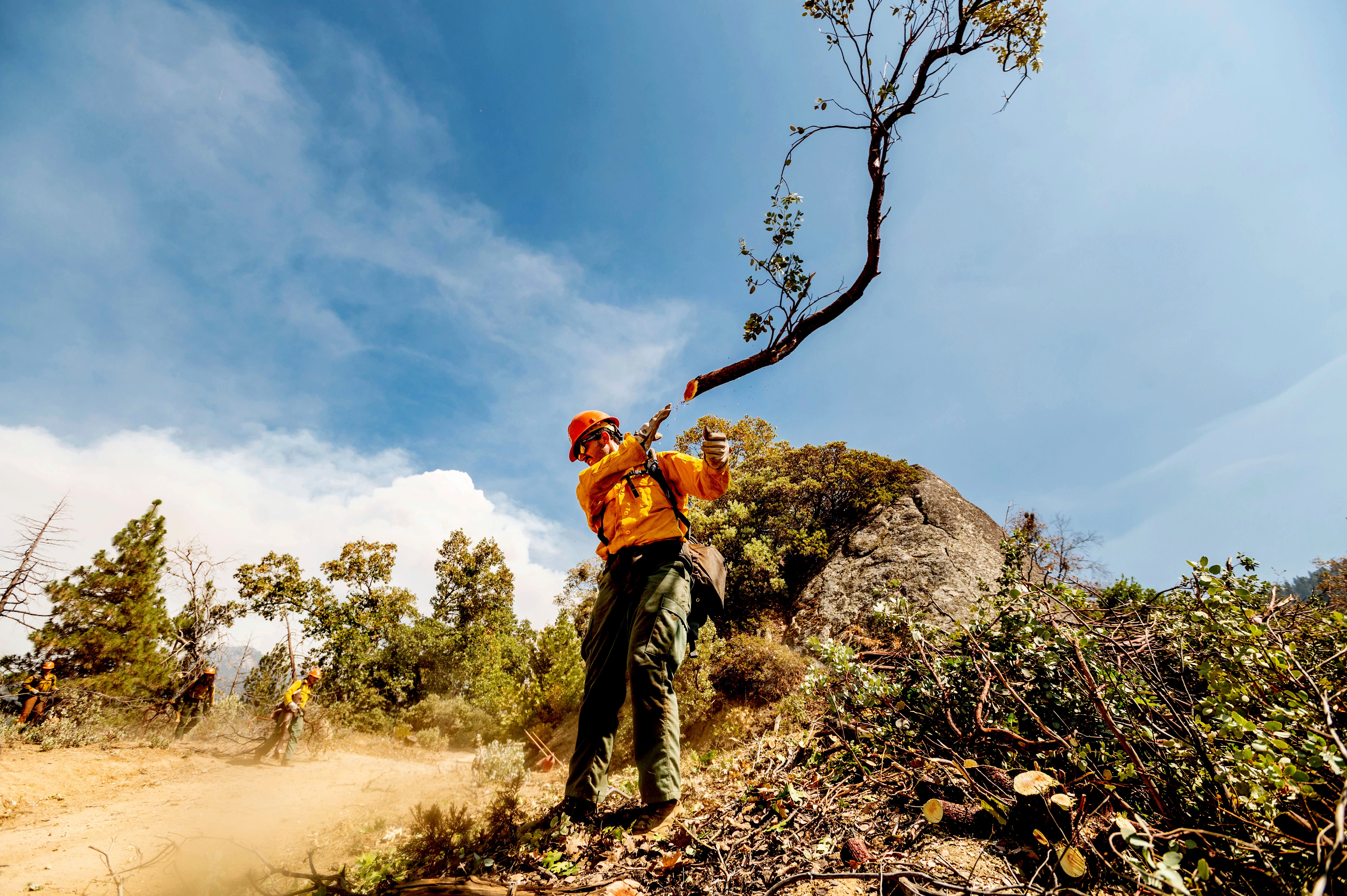Fire crews struggling to save California giant sequoias
Crews are struggling to save California's iconic giant sequoias from a lightning-caused wildfire that's heading toward old-growth forests in the Sierra Nevada

Your support helps us to tell the story
From reproductive rights to climate change to Big Tech, The Independent is on the ground when the story is developing. Whether it's investigating the financials of Elon Musk's pro-Trump PAC or producing our latest documentary, 'The A Word', which shines a light on the American women fighting for reproductive rights, we know how important it is to parse out the facts from the messaging.
At such a critical moment in US history, we need reporters on the ground. Your donation allows us to keep sending journalists to speak to both sides of the story.
The Independent is trusted by Americans across the entire political spectrum. And unlike many other quality news outlets, we choose not to lock Americans out of our reporting and analysis with paywalls. We believe quality journalism should be available to everyone, paid for by those who can afford it.
Your support makes all the difference.Firefighters wrapped the base of the world’s largest tree in a fire-resistant blanket as they tried to save a famous grove of gigantic old-growth sequoias from wildfires burning in California’s rugged Sierra Nevada
The colossal General Sherman Tree in Sequoia National Park’s Giant Forest, some other sequoias, the Giant Forest Museum and other buildings were wrapped for protection against the possibility of intense flames, fire spokeswoman Rebecca Paterson said.
The aluminum wrapping can withstand intensive heat for short periods. Federal officials say they have been using the material for several years throughout the U.S. West to protect sensitive structures from flames. Near Lake Tahoe some homes that were wrapped in protective material survived a recent wildfire while others nearby were destroyed.
The Colony Fire, one of two burning in Sequoia National Park was expected to reach the Giant Forest, a grove of 2,000 sequoias, at some point within days, fire officials said.
However, the fire didn’t grow significantly Thursday as a layer of smoke reduced its spread in the morning, fire spokeswoman Katy Hooper said.
It comes after a wildfire killed thousands of sequoias, some as tall as high-rises and thousands of years old, in the region last year.
The General Sherman Tree is the largest in the world by volume, at 52,508 cubic feet (1,487 cubic meters), according to the National Park Service It towers 275 feet (84 meters) high and has a circumference of 103 feet (31 meters) at ground level.
Sequoia and Kings Canyon national parks Superintendent Clay Jordan stressed the importance of protecting the massive trees from high-intensity fire during a briefing for firefighters.
A 50-year history of using prescribed burns — fires set on purpose to remove other types of trees and vegetation that would otherwise feed wildfires — in the parks’ sequoia groves was expected to help the giant trees survive by lessening the impact if flames reach them.
A “robust fire history of prescribed fire in that area is reason for optimism,” Paterson said. “Hopefully, the Giant Forest will emerge from this unscathed.”
Giant sequoias are adapted to fire, which can help them thrive by releasing seeds from their cones and creating clearings that allow young sequoias to grow. But the extraordinary intensity of fires — fueled by climate change — can overwhelm the trees.
That happened last year when the Castle Fire killed what studies estimate were 7,500 to 10,600 large sequoias, according to the National Park Service.
A historic drought and heat waves tied to climate change have made wildfires harder to fight in the American West. Scientists say climate change has made the region much warmer and drier in the past 30 years and will continue to make weather more extreme and wildfires more frequent and destructive.
A national interagency fire management team took command of efforts to fight the 11.5-square-mile (30-square-kilometer) Paradise Fire and the 3-square-mile (8-square-kilometer) Colony Fire, which was closest to the grove. Operations to burn away vegetation and other fuel that could feed the flames were done in that area.
The fires forced the evacuation of the park this week, and parts of the town of Three Rivers outside the main entrance remained evacuated.
To the south, a fire on the Tule River Indian Reservation and in Giant Sequoia National Monument grew significantly overnight to more than 6 square miles (15 square kilometers), and crews had no containment of it, a Sequoia National Forest statement said.
The Windy Fire, also started by lightning, has burned into part of the Peyrone Sequoia Grove in the national monument, and other groves were threatened.
“Due to inaccessible terrain, a preliminary assessment of the fire’s effects on giant sequoia trees within the grove will be difficult and may take days to complete,” the statement said.
The fire led the Tulare County Sheriff’s Office to warn the communities of Ponderosa, Quaking Aspen, Johnsondale and Camp Whitsett, a Boy Scouts camp, to be ready to evacuate if necessary.
The wildfires are among the latest in a long summer of blazes that have scorched nearly 3,550 square miles (9,195 square kilometers) in California destroying hundreds of homes.
Crews had limited ground access to the Colony Fire and the extreme steepness of the terrain around the Paradise Fire prevented it completely, requiring extensive aerial water and flame-retardant drops on both fires. The two fires were being managed collectively as the KNP Complex.
___
Antczak reported from Los Angeles. Associated Press reporter Brian Melley contributed from Los Angeles.